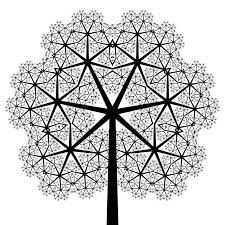Fractals does the infinite within the
finite?
Looking at the figure
above, a fractal, we can not immediately locate something in nature, why we not
have real references. The first challenge is to define the fractal, an entity
created from mathematical algorithms, using computers for thousands of
calculations required.
Sometimes we can find
correspondence between nature and the fractal, it is sometimes impossible. What is the
definition of a fractal?
We may use vague or
cryptic definitions as:
• A fractal is a
self-similar or self-similar figure,
• containing copies of
itself,
• generated recursively,
• having a clear
structure at arbitrarily small scales,
• is so irregular that
it is difficult to describe in terms of language of Euclidean geometry,
• it has a dimension
that is not whole and is increasing its topological dimension (topological
dimension is the space required to draw the fractal)
• has a simple and
recursive definition.
Gonze (2010) states that
a fractal is generally "a rough or fragmented geometric shape that can be
subdivided into parts, each of which is (at least approximately) a reduced size
copy all" (B. Mandelbrot). This property is called self-similarity. The
term was coined by Benoît Mandelbrot in 1975 and derives from the Latin fractus
meaning "broken" or "fractured".
To Liebovitch and
Shehadeh (2005: 179-180) objects in space can have fractal properties. The time
series can have fractal properties. The sets of numbers can have fractal
properties. Much of the statistics with which you are familiar show the
"linear" data properties. Fractals can help describe some
"non-linear" data properties. Most of the data are characterized by the mean and standard
deviation, and 45.3 ± 0.3; for data that are fractal, the mean and standard
deviations are meaningless. This implies a significant change in the simplest
way we see and manage the data.
Gonze (2010) states that
although they appear similar at all levels of magnification, is often
considered that fractals are infinitely complex (in informal terms). Natural
objects that seem fractals to a degree include clouds, mountains, lightning,
coastlines, and snowflakes. However, not all self-similar objects are fractals
- for example, the real line (a straight Euclidean line) is formally
self-similar but does not have other fractal characteristics (Gonze, 2010: 8).
Huang and Cheng (s / f:
3) indicate that a fractal is a set whose Hausdorff Besicovitch dimension
strictly exceeds the topological dimension (this is a very abstract
definition). In general, a fractal is defined as a rough or fragmented
geometric shape that can be subdivided into parts, each of which is (at least
approximately) a reduced-size copy of the whole. Fractals are generally
self-similar and independent of scale.
Properties of objects in space
When we expand a
non-fractal object, new details do not appear. But when we extend a fractal
object we continue to see smaller and smaller pieces. Smaller pieces are copies
of the larger pieces. They are not exact copies smaller, but are smaller very
similar to the larger pieces replicas (Leibovitch, 2005: p. 183).
A fractal object has
most parts are approximately the same size. A fractal object has pieces of all
different sizes. The variation in the size of the pieces of fractal objects is
much greater than the variation in the size of the pieces of non-fractal
objects. (Leibovich, 2005: 184-185)
Self-similarity. Small
parts are smaller than the larger pieces copies. Scale. The measured values depend on the resolution used to make the measurement
.
Statistics. The "average" size depends on the resolution used for the
measurement.
A tree is fractal. Has a
few large branches, some branches of medium size, and many small branches. A
tree is self-similar, small branches are smaller than the largest branches
copies. There is a scale length and thickness of each branch depends on what
branch we measure. There is an average size of a branch: The higher the number
of smaller branches that include, the lower the "medium" length and
thickness (Liebovitch, 2005: 187)
The pattern ray in sky is fractal. Has a few large branches, some branches of medium size, and many small branches. The beam pattern is self-similar: Small branches are smaller than the largest branches copies. There is a scale length of each ray beam depends on what we measure. There is an average size of lightning: The higher the number of smaller beams that include, the lower the "medium" length and thickness (Leibovitch; 2005: 188)
According Gonze (2010)
traditional fractal geometry is a modern invention based on a characteristic
size or scale, there is no specific description of size or scale to measure. In
traditional geometry, a formula such as x2 + y2 + z2
= R2 describes a sphere; fractals in a simple formula or
algorithm as Zn + 1 = Zn 2 + z0
describes the Mandelbrot fractal.
A set of Julia is a kind
mirror image of the Mandelbrot set. It is based on the same basic family of
functions f (x) = x2 + c. But instead of varying c (as in the
Mandelbrot set), it remains fixed and vary x c. The set of Julia c is the set
of values of x
for which the iteration of f(x) does not
diverge. There are an infinite number of Julia sets - one for each possible
value of c.
In the next installment we will show the properties and algorithms from Mandelbrot sets, Julia and others in detail.
References
Liebovitch, Larry S.; Shehadeh
Lina A. (2005) Introduction to Fractals, Chapter 5
Center for Complex
Systems and Brain Sciences, Center for Molecular Biology and Biotechnology,
& Departments of Psychology and Biomedical Sciences Florida Atlantic
University
Gonze Didier (2010) Fractals:
theory and applications
Unité de Chronobiologie Théorique Service de Chimie Physique - CP 231
Université Libre de Bruxelles Belgium
Chen Ting (Matric No.
U017596H) Huang Liming (S/F)World of fractalas
Caballero Roldan, Rafael (s/f) Caos y fractales













No hay comentarios:
Publicar un comentario
Nota: solo los miembros de este blog pueden publicar comentarios.